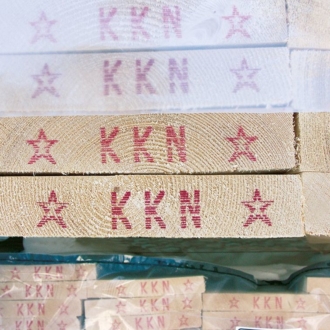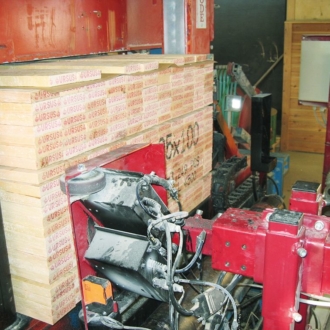Sawn timber is marked during the process before packaging. Also the packages must have the necessary product information before storage and delivery to the customer.
Marking
Marking or labelling information contains at least:
- Sawn timber end marking
- Sawn timber face marking
- Timber package information marking

© Koskisen Oy
The end marking, ie the traditional stamping means that the shipping mark of the sawmill is marked at the end of the piece of sawn timber. This is normally done on the packing conveyor. When the roller conveyor has moved the pieces of sawn timber so that the butt ends are on the same level, and the feeding device has moved them one at the time between the rakes of packing conveyor, the packing conveyor passes the pieces of sawn timber over the stamping device.
Stamping
Previously, the roll stamping was the most common method stamping. The stamp plate is attached to the rotating cylinder. At every turn the stamp plate takes stamp colour from the colour pad and stamps the piece of sawn timber passing by. The rotation speed of the cylinder is synchronized with the speed of the packaging conveyor.
The inkjet printers are displacing the roll stamp. Nowadays the shipping mark is sprayed with the coloured ink on the end of the piece of sawn timber.
The inkjet printer has a photo cell that gives the impulse to start printing when recognizing the passing piece of sawn timber. Stamp templates are programmed on the control computer of the printer. When the quality and / or the dimension changes, the operator selects the stamp to use from the memory of the printer.
In addition to the shipping mark, more information can be printed to the end of the piece of sawn timber. For example, there can be on other, smaller inkjet printer next to the printer for the top end. This printer can be used to print the packet number under predetermined intervals under the shipping mark. In this case the shipping mark is programmed to be printed on top of the end of the piece of sawn timber, leaving space for the package number printed with small font.
Inkjet printers for sawmilling industry are supplied, among others, Eaton-Finland Oy, EnviOn Oy and Suomen Teollisuusmerkintä Oy.
Face marking
Face marking means printing different information on the flat side of the piece of sawn timber. The first marking is often made at the sorting plant, when the ID number of the sorter is printed on the flat side of the piece of sawn timber. The inkjet printer is located above the conveyor line and according to the information provided by the control system of the line, the ID number of each sorter is printed on the flat side.
An inkjet printer located above the conveyor line can also print the length of the piece on the flat side of the piece of sawn timber.
The inkjet printer installed in connection with strength grading machine will, in turn, print the strength grade of each piece on the flat side of the piece of sawn timber.
The IPPC-stamp can be printed with an inkjet printer on the flat side of the piece of sawn timber on the packing conveyor. This is an ISPM 15 standard for wooden packaging material under the IPPC (International Plant Protection Convention) which defines the handling and marking requirements for packaging material. Its purpose is to prevent plant pests to spread from country to another with wooden packaging material.
Labels
The marking of the timber package means the labelling of the packet and possible information added on the side of the packet. The size of the label varies a lot and depends on the needs of sawmill, logistics and customer.
The label may include:
- the package number
- dimension
- quality
- length
- weight
- shipping codes of sawn timber.
On the label, the package number is printed also in a bar code, whereby the driver of the fork lift truck can read the packet data from the cab with a bar code reader and get the stock address of that packet direct to the computer of the fork lift truck. Labels are usually printed in two and attached to the end of the package and to one side on of the packet.
Side marking
When an automatic side marking of the timber package is made with an inkjet printer, a transfer device is installed on the side of the conveyor line for the inkjet printer. When the timber package moves forward on the conveyor and comes to the inkjet printer, the transfer device moves the printer against the side of the package. The printing takes place when the package moves forward.
The inkjet printer device for side marking is bigger than the one for end marking, therefore larger fonts can be used for those markings.
Information printed on the side of the package:
- the package number
- the B/L (bill of lading) number
- the weight of the package
- dimensions and quality of sawn timber or the quality codes of saw mill
- the volume of the package
- the shipping information
If an automatic printer is not used, the operator manually writes the information to the side and end of the package.


